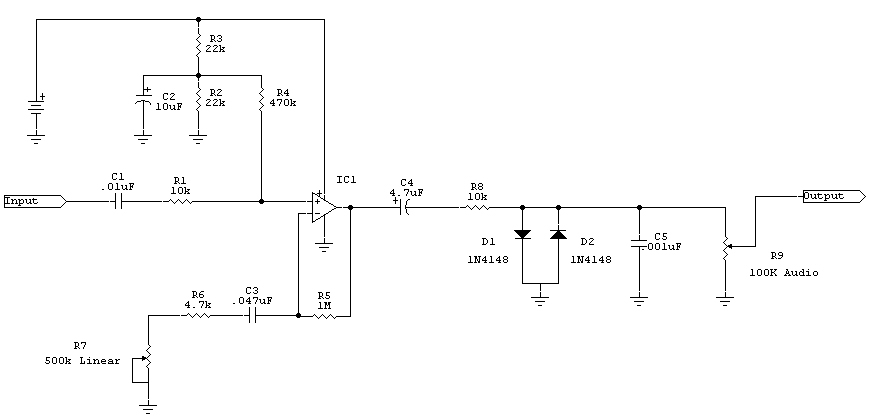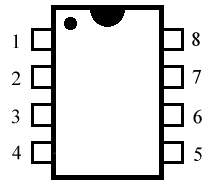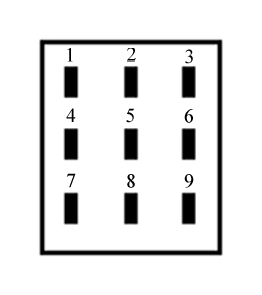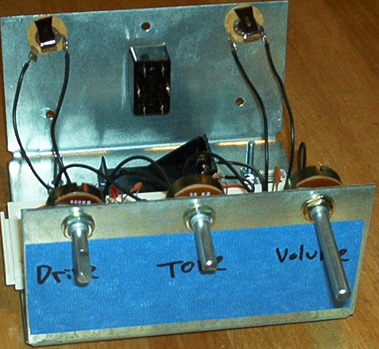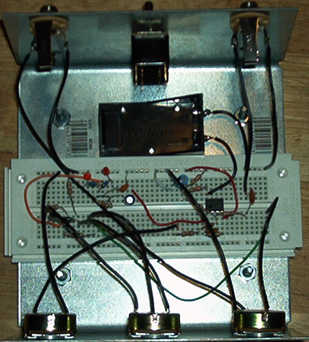Building a DOD 250 Guitar Effects Pedal
Welcome to my little page on how to put together a DOD 250 distortion pedal. I chose this circuit because it’s very simple and a very easily modifiable circuit. There are some easy circuits out there for beginners, but this is for those of you that want to build pedals so you can make some noise! I also wanted to put a little page together for beginners, but with a lot of information that took me a long time to get. So, hopefully, a beginner can read this page, build the circuit, and be very confident about continuing on with stompbox building – without a lot of research outside of this page. That being said, I am not going to discuss everything about effects building (there’s tons of info out there), but I am going to show you how to build a simple pedal in what I hope is a unique and easily understood way. Basically, it’s the stuff that I wish I had known before my first build.
I also wanted to give something back to the “community” that has given so much to me. PLEASE check out Aron’s Site! And when I say go to Aron’s site, I mean begin there and then start checking all of the links on his site. There are many great sites (GEOFEX, AMZFX, General Guitar Gadgets, Small Bear, etc…), but you can get to them all from Aron’s place. It’s like the hub of the stompbox universe. And if you have a question, just ask on Aron’s Stompbox Forum. They are very helpful.
Also, in 2003, I was going through a tough time (with my newborn son in the hospital for almost four months – he made it home and is a very healthy soon-to-be toddler!) and Marty B. from Aron’s Forum was kind enough to send me a couple of PCB’s (printed circuit boards) to keep my mind occupied while I awaited my son’s recovery. Since I’m still a novice, I figured that I couldn’t send him something that he couldn’t just build himself (and probably better than I could), but I could immortalize his generosity in this little page on the web! Here’s to you, Marty!
Here’s the schematic for the DOD 250:
Pretty cool, huh? Now, I am going under the assumption that you can read a schematic. If not, go to Aron’s Forum and read the FAQ.
And here’s a parts list (bill of materials) for the circuit:
RESISTORS:
R1 – 10k
R2 – 22k
R3 – 22k
R4 – 470k
R5 – 1M
R5 – 4.7k
R8 – 10k
CAPACITORS:
C1 – .01uF
C2 – 10uF Polarized
C3 – .047uF
C4 – 4.7uF Polarized
C5 – .001uF
MISCELLANEOUS:
IC1 – some type of Op-Amp (see below)
D1 – 1N4148 Diode
D2 – 1N4148 Diode
R7 – 500k Linear Potentiometer (a reverse log pot would work better, but can be hard to find)
R9 – 100K Audio Potentiometer
The first thing you will need to do is get the parts. To start out, you can just grab them at Radio Shack or some other local electronics store. Once you get into building, you will be much better off with mail order places (better selection, higher quality, way cheaper prices). I like Mouser Electronics for most stuff and Small Bear for the specialty items that Mouser doesn’t carry. But Radio Shack is great if you’re only getting a few things, and don’t want to wait for delivery, and possibly get the wrong stuff (at Radio Shack you can just return it and get the correct item).
For the resistors, you can use carbon composition, carbon film, or metal film. Carbon composition resistors are generally noisier and larger, so I wouldn’t recommend them. Carbon film are more readily available and cheaper, but metal film is a little quieter (and we all know that noise in your signal is not cool). In my experience, carbon film resistors work just fine – especially for a first time builder. And you only need 1/4 watt or 1/2 watt sizes.
For the non-polarized capacitors, you can get ceramic, metalized film, mica, polyester… many different types. And there is endless debate over what types work best in what circuits. Ceramic caps are the easiest to find and the cheapest and they are fine to use. Polyester and metal film are more expensive, but they are also quieter. Again, it’s up to you. How much do you want to spend and what do you have available? You decide – they will all work.
For the polarized caps, I use electrolytic capacitors. And I’ve never had a problem. There are a few other types, but for now, go with these.
Grab the potentiometers and the diodes and an Op-Amp (or IC). For the IC, I like the 4558 or 4559, but there are dozens that you can use (the 741 was in the original circuit, and it works great, but it can be a bit noisy). Just make sure that you understand the pinout, so you know what should be connected to what.
There are two types of op-amps that come in an 8-pin package. The first is a single op-amp, and the second is a dual op-amp. Since you are only going to use one of the op-amps, either one will work. With the dual, you have an extra one that just does nothing. It’s internal, so “out of sight, out of mind.” But don’t feel that it would be wasteful to use a dual, because there are MANY more options in a dual package. So, if you wanted to try switching different ones to see what you liked better, you have more to work with in the dual package. But either will work just fine.
Here is a quick introduction to the pinout of single and dual op-amps. If you hold the op-amp so that it’s standing on its legs (like a little bug) and you are looking at the top of it (the part with the part number printed on it), you should notice a little circle near one corner or a half circle on one end. Position the op-amp so that the legs and circle match this diagram:
The pins are numbered 1-8 starting at the upper left corner and looping around to the upper right corner. Now that you have this figured out, here are what the pins mean and what they connect to.
Single op-amp:
1 – Offset Null (leave unconnected)
2 – Inverting Input (this is the (-) inside the triangle on the schematic – connect to R5 and C3)
3 – Non-Inverting Input (this is the (+) inside the triangle on the schematic – connect to R1 and R4)
4 – -V (connect to ground)
5 – Offset Null (leave unconnected)
6 – Output (connect to R5 and C4)
7 – +V (connect to battery (+))
8 – No Connection (leave unconnected)
Dual op-amp:
1 – First Op-Amp Output (connect to R5 and C4)
2 – First Op-Amp Inverting Input (this is the (-) inside the triangle on the schematic – connect to R5 and C3)
3 – First Op-Amp Non-Inverting Input (this is the (+) inside the triangle on the schematic – connect to R1 and R4)
4 – -V (connect to ground)
5 – Second Op-Amp Non-Inverting Input (leave unconnected)
6 – Second Op-Amp Inverting Input (leave unconnected)
7 – Second Op-Amp Output (leave unconnected)
8 – +V (connect to battery (+))
There is MORE than enough information out there on Op-Amps, so do some research!
Also, I highly recommend using an IC socket. This is a little doo-dad that allows you to solder it all together, then just pop the IC right in. This saves you possibly frying the IC while soldering, and allows you to try different IC’s (which we will get to later).
Now, if you can’t find the exact parts, don’t panic. You can substitute many different parts and still end up with a working circuit. This will be explained later on, so read the whole page before you go shopping! Also, with the modifications, although you can get a lot of great sounds, try building the original circuit first before you start changing parts. This way, if you have a problem with the finished pedal, you know that it wasn’t something that you changed that messed it all up!
You will also need the “hardware” for your pedal. You will need a stereo 1/4″ jack, a mono 1/4″ jack (in a pinch, you could use two stereo or two mono jacks), a stomp switch (see Small Bear), an enclosure (I recommend the cheap ones you can get at Radio Shack for $2.99 because they are big enough so you have a little elbow room and if you mess up the drilling, you can just grab another one and it would still be cheaper than getting a Hammond enclosure), knobs with a set screw, some perfboard, stranded wire, a 9V battery clip and a 9V battery, and an optional AC jack and AC adapter.
And you will need tools. A soldering iron (you can just get a cheap “soldering pencil” for $5-$10), solder, a drill (I like a cordless electric drill), a Unibit (it’s a neat drill bit thing that allows you to drill different sized holes all with the same bit), a wire cutter and wire stripper, pliers or ratchet set to fasten the pots and jacks and stomp switch to the box, and some assorted screwdrivers (for the knob set screws and the enclosure).
Now, you’re ready to start. I usually begin with drilling the box because it starts to look like a pedal very quickly – very satisfying!
* * * WEAR SAFETY GLASSES FOR ALL DRILLING AND SOLDERING * * *
Toss some masking tape on the top of the box, near the center, running the long way. On the tape, measure and draw a line exactly down the center of the box. Along this center line, decide how far up you want the stomp switch, and draw a little “X” at that spot. Now, figure out where you want to position the two knobs. Draw a line perpendicular to the center line, and mark the two spots with another “X” – make sure that you are allowing enough room so that the potentiometers will fit inside the box and so that the knobs will fit without touching or hanging over the edge of the box. And decide where you want the LED indicator, and mark that, too.
Using this same technique, lay out where you want the jacks to go on the sides of the box. Traditionally, they will go one on each side (left and right) or both on the side that faces away from you while using the box. And the AC adapter can go on one of the sides or the side that faces away from you. When laying all this stuff out, use some imagination and some measuring to make sure that when you put the parts on the box, nothing is blocking anything else. This is one reason I like larger enclosures! You also need to keep room for the circuit board and the battery. If you have one of the Radio Shack boxes I recommended (4″X4″X6″), you’ll have plenty of room, but you still don’t want pots in the way of jacks or whatever.
Now, measure how big you need each hole to be (I use a drill bit gauge — that plastic thing with different sized holes all over it) and write down the measurements next to each “X” on the masking tape. If you don’t have a drill bit gauge, you can start with a small hole and keep stepping up (with that cool Unibit) until the part fits. But be careful. If you drill the hole too big, you’re out of luck.
Once that’s all done, you can take the tape off, clean off the box (watch those little metal shavings!), and paint it. Check online for ways to finish the box. Or leave it plain. This is just your first one anyway!
After you’ve finished the box, you can attach the pots, put the knobs on the pot shafts, and attach the switch, jacks, and LED and LED holder. Doesn’t it look cool?
You’re ready for the circuit, now.
* * * WEAR SAFETY GLASSES FOR ALL DRILLING AND SOLDERING * * *
Cut the perfboard to a decent size. By that, I mean, small enough so that it will fit somewhere inside the box, but big enough so that you have room to layout and solder the parts comfortably. I would say 1 1/2″ by 3″ is a good size. To cut the perfboard, I score it along a row of holes with an X-Acto knife, then it just snaps.
When you start “populating” the board with the components, it may be a good idea to lay them out just like they are on the schematic. This way you won’t get lost as easily, and the parts will be near the parts that they need to be soldered to. When you stick the component leads through the holes, you should give them a little twist where they are to be soldered together. For example, twist the right-hand lead of C1 and the left-hand lead of R1 together. If you do it this way, then you can easily undo anything that doesn’t quite layout well on the board.
Once you have everything on the board where you want it (watch the polarity of the polarized caps and the pinout of the IC socket), you can solder what needs to be soldered. Then clip the excess leads off and you have a nice, neat circuit board.
Now, all you need to do is wire the “off-board” components. These are the pots, jacks, battery clip, and stomp switch. I will usually wire the pots first because they are actual circuit components and are not involved with the stomp switch (which is a whole other ball of wax). For some reason, I always have trouble wiring pots. No matter how careful I am, and how positively sure I am that I’m doing it correctly, I always get one that works backwards. If this happens, simply switch the two outer lugs.
And now… the stomp switch wiring.
* * * WEAR SAFETY GLASSES FOR ALL DRILLING AND SOLDERING * * *
If we look at the bottom of a 3PDT switch, we see nine lugs in three rows of three. Let’s number them 1-9 from top left to bottom right.
Make sure that you orient the lugs so they line up with the diagram (the lugs look like little rectangles when viewed from the underside of the switch, so make sure they are running vertical just like in the diagram).
I also want to define the jack parts. The “ring” is the part of the jack that encircles the hole. It’s the ground part. The “sleeve” is the middle contact that touches the metal shaft of the plug. The “tip” is the very end of the plug (the longest contact on the jack). I hope this makes sense.
And here are the 15 easy steps to wire a 3PDT switch for true bypass and LED indicator.
1 – Connect pins 3 and 6
2 – Connect circuit input to pin 5
3 – Connect pins 4 and 9
4 – Connect pin 4 to the input jack tip
5 – Connect pin 2 to circuit ground
6 – Connect pin 1 to the indicator LED cathode (-)
7 – Connect pin 7 to circuit output (usually the volume pot)
8 – Connect pin 8 to the output jack tip
9 – Connect output jack ring to circuit ground
10 – Connect input jack ring to output jack ring
11 – Connect LED anode (+) to a 1K-10K resistor, then to circuit (+) (A lower value will give a brighter LED, but drain the battery faster, so experiment and see what you need)
12 – Connect battery negative to input jack sleeve
13 – If no AC adapter, connect battery positive to circuit (+), and you’re done!
14 – If you have an AC adapter, connect battery positive to middle lug on AC jack (so that the “switch” disengages when a plug is inserted)
15 – Connect AC jack tip to circuit (+), and you’re done!
And now, onto what the parts of the circuit do and what modifications you can make to the circuit. Just remember that changing one thing will likely change more than one aspect of the resulting tone because of the interaction of the different elements in the circuit. So, feel free to play around, but always listen to what the circuit sounds like after each change.
C1 is the Input Cap. This sets the tone going into the circuit. A smaller value cuts more bass out of your signal and a larger value lets more bass in. So, a .001uF capacitor would create a more high-endy pedal because it’s one-tenth the value of the original capacitor. Likewise, a .022uF capacitor would create a bass-ier sounding pedal. A lot of people like to socket this component and then plug in different capacitors and see what they like for their individual guitar and amp setup.
R1 help set the Input Impedance and filters out radio frequencies (RF is bad). This is best left alone. Things will work better using the 10K.
C2 is a Filter Cap for the DC current (battery). Not much happens playing around with 10uF value, but I’ve seen values ranging from 1uF to 100uF – so, whatever.
R2 and R3 are Voltage Dividers. This means that they take the 9V and feed 4.5V to the Op-Amp. Again, nothing much happens playing with these values, except that the values need to be the same. You can use values from 10K to 1M. Lower values use up more battery power, then higher values. But I like sticking with what the schematic calls for.
R4 sets the bias for the Op-Amp. This is best left as is.
R5 is the Feedback Resistor. This works with R6 and R7 to set the gain level of the Op-Amp. If we look at R6 and R7 as one resistor, and we know that R7 is variable from 0 to 500K, then the two resistors together are variable from 4.7K to 504.7K. Now the way the gain is calculated, you divide R5 by the sum of R6 and R7. So, if R7 is all the way to 0, it would be 1,000,000/4,700 which gives us a gain of 212.77. So, the guitar signal will be amplified over 200 times. If R7 is turned to 500K, the gain would be 1,000,000/504,700. This is a gain of 1.98 – just under 2 times. I like to play with the value of R6 to adjust gain. A lower value will give more gain, and a higher value will give less gain. You can also play with the value of the pot (or even the feedback resistor), just keep in mind the calculations for gain.
C3 also affects the tone of the circuit. A larger value here will cut highs, and a lower value will cut bass. Mess around with this component.
IC1 can be any number of Op-Amps. And they all sound slightly different. And when I say slightly, I mean SLIGHTLY. There is a lot of debate over the differences (and even if there are any differences). I can hear differences if I do a side-by-side comparison, but it is very subtle. And playing with caps and resistors has a much, much bigger effect on the sound of the pedal. So, don’t get too wrapped up in the Op-Amp. But on the plus side, you can use tons of different ones and still end up with a cool pedal.
C4 is the Coupling Capacitor. It blocks DC current from continuing onto the output. I have seen values from 2.2uF to 22uF used.
R8 – I think this sets the output impedance so the pedal will play well with others. If there is something funky with the impedances, pedals start to act strangely.
C5 helps cut some high end out of the signal because creating distortion also creates harsh higher frequencies. This helps “smooth out” the distortion. Feel free to play with this capacitor.
R9 is the Volume Pot. Not much happens here with different values (you could use anything from 20K to 1M). A higher value pot will allow a little more volume, but this pedal should have more than enough volume for you anyway.
And the diodes. These are fun to fool around with. What is happening here (in the circuit), is that the Op-Amp boosts the signal, then the diodes clip the tops of the waveform off, and this creates distortion. Again, there is a wealth of information on the internet about this, so feel free to research this. There are a few common types that are used and they all sound a little different. Different diodes clip at different voltages, so a lower clipping threshold will create more distortion but a lower overall volume, and diodes with a higher clipping threshold will give less distortion, but more volume. The types of diodes generally used are (in order from lower clipping threshold to higher): germanium diodes, silicon diodes, 3mm LED’s, 5mm LED’s. Feel free to experiment. Socketing these diodes may be a good idea. Also, the diodes are set up in the original circuit to produce symmetrical clipping. This means that the signal is clipped the same amount on both sides of the waveform. Many people like asymmetrical clipping better. This can be achieved by mismatching the diodes. Either use two diodes with different clipping thresholds or add another diodes in series with one of the original diodes. This creates one side with twice the clipping threshold (this side will clip less). I have become quite fond of using a 6 position rotary switch. This way you can switch between 6 different sets of diodes. I can get a LOT of different distortion tones with this setup.
You can also toss stuff into the feedback loop of the op-amp. If you add two back-to-back diodes (one going one way and the other going the other way) between the output of the op-amp and the inverting input of the op-amp, you will get even more fuzziness. You can put diodes in the feedback loop, and take the original diodes out, and you will get a softer distortion (more of an overdrive like a Tube Screamer pedal).
Also, you can put a capacitor in the feedback loop. This can help smooth out some of the high end in the distortion. Try capacitors in the 20pF to 100pF range. This is a subtle change, but you may like it.
If, after building your first pedal, you really like the idea of trying out different things (like I did), you may want to try something like this.
It’s a great way to prototype circuits. It’s a $4.00 post anchor for 6″X6″ wooden beams that I got at the local hardware store, and I drilled some holes in it for pots and jacks and an on/off switch (it has little holes for nails or screws, and they make excellent pilot holes), put little rubber feet on the bottom, stuck a solder less breadboard and a battery holder into it with double-sided tape, then I label everything with masking tape. It’s been VERY useful and it’s easy to change pots and whatnot.
Here are some pictures:
Well, I hope that you found this informative and helpful!
You can thenk me by checking out and subscribing to my YouTube channel:

